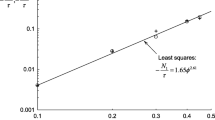Abstract
We present a model for the shear viscosity of non-colloidal suspensions with Newtonian matrix fluids. The model is based on the original idea first presented by Brinkman (Applied Sci Research A1:27-34. 1947) for the viscous force exerted by a flowing fluid on a dense swarm of spherical particles. In particular, we consider an inertialess suspension in which the mean flow is driven by a pressure difference, and simultaneously, the suspension is subject to simple shear. Assuming steady state, incompressibility and taking into account a resistance force which is generated due to the presence of the particles in the flow, the three-dimensional governing equations for the mean flow around a single spherical particle are solved analytically. Self-consistency of the model provides a relationship between the resistance parameter and the volume fraction of the solid phase. A volume, or an ensemble, averaging of the total stress gives the bulk properties and an expression for the relative (bulk) viscosity of the suspension. The viscosity expression reduces to the Einstein limit for dilute suspensions and agrees well with empirical formulas from the literature in the semi-dilute and concentrated regimes. Since the model is based on a single particle and its average interaction with the other particles is isotropic, no normal stress differences can be predicted. A possible method of addressing this problem is provided in the paper.





Similar content being viewed by others
References
Batchelor GK (1970) The stress system in a suspension of force-free particles. J Fluid Mech 41:545–570
Batchelor GK, Green JT (1972) The determination of the bulk stress in a suspension of spherical particles to order c2. J Fluid Mech 56(3):401–427
Barnes HA (2003) A review of the rheology of filled viscoelastic systems. Rheology Reviews:1–36.
Brady JF, Morris JF (1997) Microstructure of strongly sheared suspensions and its impact on rheology and diffusion. J Fluid Mech 348:103–139
Bergenholtz J, Brady JF, Vicic M (2002) The non-Newtonian rheology of dilute colloidal suspensions. J Fluid Mech 456:239–275
Brinkman HC (1947) A calculation of the viscous force exerted by a flowing fluid on a dense swarm of particles. Appl Sci Res A1:27–34
Cox RG, Zia IYZ, Mason SG (1968) Particle motion in sheared suspensions XXV. Streamlines around cylinders and spheres. J Colloid Interface Sci 27(1):7–18
Dai SC, Bertevas E, Qi F, Tanner RI (2013) Viscometric functions for non-colloidal sphere suspensions with Newtonian matrices. J Rheology 57:493–510
Denn MM, Morris JF (2014) Rheology of non-Brownian suspensions. Ann Rev Chem Biomol Eng 5:203–228
Durlofsky L, Brady JF (1987) Analysis of the Brinkman equations as a model for flow in porous media. Phys Fluids 30:3329–3341
Einstein A (1906) Eine Neue Bestimmung der Molekul Dimensionen. Ann Phys 19:289–305
Einstein A (1911) Berichtigung: Eine Neue Bestimmung der Molekul Dimensionen. Ann Phys 34:591–592
Hill RJ, Koch DL, Ladd AJC (2001) The first effects of fluid inertia on flows in ordered and random arrays of spheres. J Fluid Mech 448:213–241
Howells ID (1974) Drag due to the motion of a Newtonian fluid through a sparse random array of small fixed rigid objects. J Fluid Mech 64:449–475
Housiadas KD, Tanner RI (2012) The drag on a sedimenting sphere in a sheared weakly viscoelastic fluid. J. Non-Newtonian Fluid Mech 183:52–56
Kao SV, Cox RG, Mason SG (1977) Streamlines around single spheres and trajectories of pair of spheres in two-dimensional creeping flows. Chem Eng Sci 32:1505–1515
Krieger IM, Dougherty TJ (1959) A mechanism for non-Newtonian flow in suspensions at rigid spheres. Trans Soc Rheol 3:137–152
Landau LD, Lifshitz EM (1959) Fluid mechanics. Pergamon Press, London
Leal LG (2007) Advanced transport phenomena. Cambridge University Press, New York
Maron SH, Pierce PE (1956) Application of Ree-Eyring generalized flow theory to suspensions of spherical particles. J Colloid Sci 11:80–95
Morris JF (2009) A review of microstructure in concentrated suspensions and its applications for rheology and bulk flow. Rheol Acta 48:909–923
Pasquino R, Grizzuti N, Maffettone PL (2008) Rheology of dilute and semidilute noncolloidal hard sphere suspensions. J Rheology 52(6):1369–1384
Pivkin IV, Caswell B, Karaniadakis GM (2011) Reviews in computational chemistry, vol 27, chapter 2, edited by Kenny B. Wiley, Lipkowitz
Rallison JM (2012) The stress in a dilute suspension of liquid spheres in a second-order fluid. J Fluid Mech 693:500–507
Santamaria-Holek I, Mendoza CI (2010) The rheology of concentrated suspensions of arbitrarily-shaped particles. J Colloidal Interface Sci 346:118–126
Sierou A, Brady JF (2002) Rheology and microstructure in concentrated noncolloidal suspensions. J Rheology 46:1031–1056
Singh A, Nott PR (2000) Normal stresses and microstructure in bounded sheared suspensions via Stokesian dynamics simulations. J Fluid Mech 412:279–301
Singh P, Hesla TI, Josheph DD (2003) Distributed Lagrange multiplier method for particulate flows with collisions. Int J Multiph Flow 29(3):495–509
Stickel JJ, Powell RP (2005) Fluid mechanics and rheology of dense suspensions. Annu Rev Fluid Mech 37:129–149
Tanner RI, Dai SC, Qi F, Housiadas KD (2013a) Viscometric functions of semi-dilute non colloidal suspensions of spheres in a viscoelastic matrix. J Non-Newtonian Fluid Mech 201:130–133
Tanner RI, Qi F, Dai S-C (2013b) Scaling the normal stresses in concentrated non-colloidal suspensions of spheres. Rheol Acta 52:201–295
Yantsios SG (2012) On the distributed Lagrange multiplier/fictitious domain method for rigid-particle-laden flows: a proposition for an alternative formulation of the Lagrange multipliers. Int J Numer Meth Fluids 70:1027–1047
Zarraga IE, Hill DA, Leighton DT (2000) The characterization of the total stress of concentrated suspensions of noncolloidal spheres in Newtonian fluids. J Rheol 44(2):185–220
Acknowledgment
We thank the Australian Research Council for supporting part of this work via Grant DP110103414.
Author information
Authors and Affiliations
Corresponding author
Rights and permissions
About this article
Cite this article
Housiadas, K.D., Tanner, R.I. A model for the shear viscosity of non-colloidal suspensions with Newtonian matrix fluids. Rheol Acta 53, 831–841 (2014). https://doi.org/10.1007/s00397-014-0800-4
Received:
Revised:
Accepted:
Published:
Issue Date:
DOI: https://doi.org/10.1007/s00397-014-0800-4




